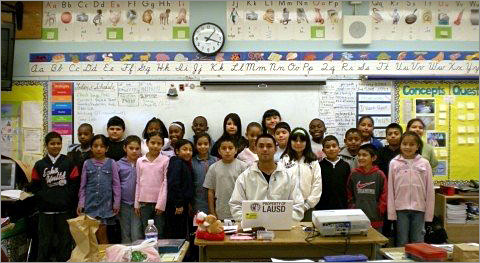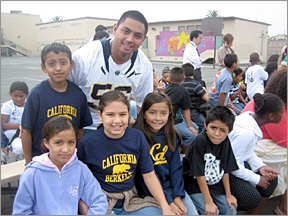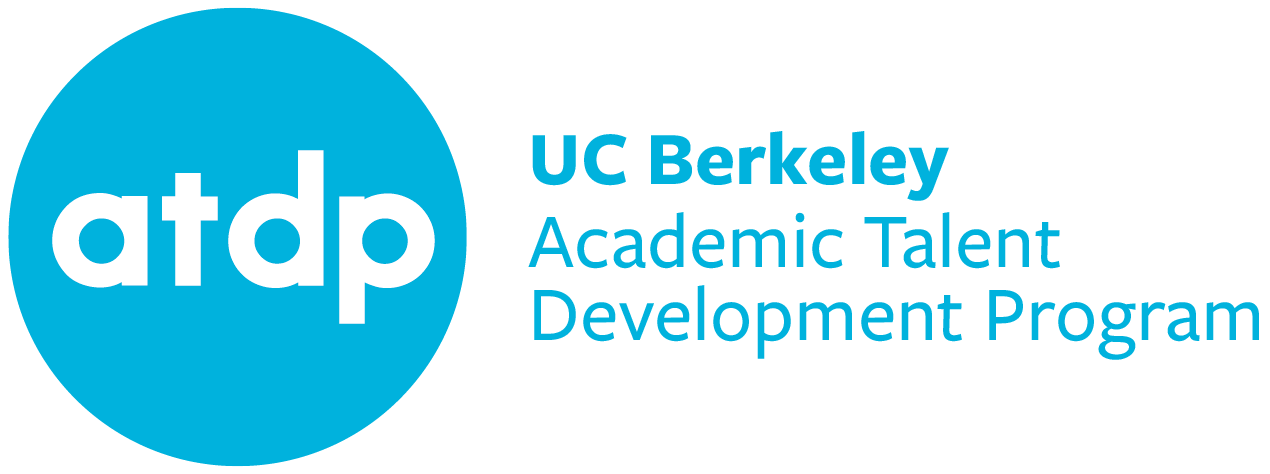A young teacher’s journey
It always starts with one teacher, and one or two students. More than 20 years ago, a middle school math teacher in California’s Central Valley saw great academic promise in one of her students, and thought he’d be a good fit at a summer acdemic program for gifted students at the UC Berkeley campus.
Through Nancy Mellor’s enthusiastic recommendation, Ricardo Gonzalez, her mentee and a child of Mexican-American immigrant farm workers, was accepted at the then-UC Berkeley Gifted Program. From those auspicious beginnings Coalinga-Huron House became an institution at the Gifted Program/ATDP, sending eager, talented, motivated students to Berkeley summer after summer.
Ryan Maquiñana may or may not have heard of CHA House when he was a student at ATDP, in the summer of 1999 and 2000. If not directly, he could have imbibed its ethos via osmosis, if there were some CHA students in Frank Worrell’s AP Psychology class in 2000, or Bette Spagel’s AP Economics class during the summer of 1999. However it might have happened, Ryan became infected with this particular virus—which would manifest itself in his own life a decade later, in 2009.
Because this summer, Ryan is bringing three of his students from the school he teaches at, in inner-city Los Angeles, to participate in ATDP’s Elementary Division program. But first, a bit of the back story…
After graduating from UC Berkeley in 2005 with a degree in Legal Studies and Business Administration, Ryan took a job as a fourth-grade teacher at the 109th Street Elementary School in Watts, CA. Meanwhile, he pursued and obtained an M.A. in Education at Loyola Marymount in 2007. As anyone familiar with mid-20th American history would know, Watts has a reputation as a troubled ghetto in the metropolitan Los Angeles area, populated largely by working-class African Americans. Blacks used to comprise a majority of the population at Watts, but these days Hispanics have become the majority there. I imagine Ryan’s school, and classroom, is comprised mostly of black and brown faces. (Actually, it is:)

From perusing Ryan’s Facebook photos and journals, it’s easy for me to see that it wasn’t just all about teaching math in the classroom, for Ryan. A hugely important part of his experience at his school was getting his students excited about higher education, even as fourth graders. He would take them to field trips to basketball and baseball games at USC or UCLA whenever his beloved Cal Golden Bears would be in town, and fundraise to get Cal jerseys, caps and other paraphernalia for the kids.
Sometime in the fall of 2008, Ryan got three of his young students to somehow see themselves as applying to, and attending, UC Berkeley—not far in their future, but the next summer! And to do so by applying to ATDP’s 3-week Elementary Division program. In his e-mail to me explaining what he had done, a simple declarative sentence says it all: “They are really excited about the prospect of taking classes in such a special program and visiting Cal for the first time.”
 “They” were Esmeralda Landeros, Domoinique Snelson, and Ceily Velasquez. Even before they got accepted to the ED, the three kids were so thrilled to just be applying, and proudly wore the Cal sweatshirts and t-shirts that their teacher and mentor got for them, in fondest hopes of admission to ATDP. During the admission period, in an e-mail from Ryan, he wrote “The kids have been calling me almost every day about it. haha. I have attached their picture below if you would like to see what they look like.” If ATDP Director Nina Gabelko had seen this picture before she even read the students’ formal applications, she would probably have admitted and placed them on the spot, application unseen. :-)
“They” were Esmeralda Landeros, Domoinique Snelson, and Ceily Velasquez. Even before they got accepted to the ED, the three kids were so thrilled to just be applying, and proudly wore the Cal sweatshirts and t-shirts that their teacher and mentor got for them, in fondest hopes of admission to ATDP. During the admission period, in an e-mail from Ryan, he wrote “The kids have been calling me almost every day about it. haha. I have attached their picture below if you would like to see what they look like.” If ATDP Director Nina Gabelko had seen this picture before she even read the students’ formal applications, she would probably have admitted and placed them on the spot, application unseen. :-)
For in such smiles are the very brightest hopes of the future emblazoned. Is there any question that these kids are highly motivated? And clearly, under the tutelage of a teacher such as Ryan, academically talented? The answer came after May 1, when letters of acceptance were sent out to Elementary Division applicants to the ATDP. Three such letters went to Watts, letting the recipients (and their parents) know that they’d been accepted to ATDP’s Summer 2009 session, and placed in Paul Bruno and Patty Holman’s Human Anatomy and Physiology class (PM section).
The phone call I got from Ryan, when he heard the wonderful news, was just filled with palpable excitement, joy, and a sense of young people making one small step towards both the immediate and distant future of productive and engaged schooling. Immediately, he activated his extensive network of Bay Area contacts to set up a summer housing situation for his students and their parents.
In an extraordinary journal he posted recently on his Facebook page, Ryan shared a very personal reflection on his experiences of life and teaching in Watts. He mused about the challenges he sees daily in the communities around his school, but also about the extraordinary can-do energy in the families who live there, of the great hopes and expectations they have for the future of their children, particularly as it has to do with their schooling.
The journal entry was titled What’s at Stake, and Ryan wrote: “From the perspective of an inner-city public school employee, I only hope that their teachers are leading these kids in the right direction, because while I’ve seen a myriad of excellent educators in Watts, the fact of the matter is the amount of potential their children will tap into is basically at the mercy of the quality of their school, for better or for worse.” (Read the whole journal at this page on the Virtual ATDP, where it has been reposted with Ryan’s permission.)
 Indeed, the quality of each school varies widely, but it’s dedicated young teachers like Ryan who take the further step of adding immense value to the teaching that occurs within the four walls of their classrooms. It is not within their immediate mandate and responsibility as school teachers, but exposing young minds to the learning possibilities in extra-curricular programs such as ATDP seems like the natural thing for a teacher to do; particularly if she already has experiences with—and links to—such programs, as Ryan has had at ATDP.
Indeed, the quality of each school varies widely, but it’s dedicated young teachers like Ryan who take the further step of adding immense value to the teaching that occurs within the four walls of their classrooms. It is not within their immediate mandate and responsibility as school teachers, but exposing young minds to the learning possibilities in extra-curricular programs such as ATDP seems like the natural thing for a teacher to do; particularly if she already has experiences with—and links to—such programs, as Ryan has had at ATDP.
It is teachers like Ryan who support their students, often out of their own pockets, who are without doubt among the best and brightest that American society can produce. And, more importantly, among the most compassionate and visionary. Who knows, in perhaps another two decades, we’ll be talking about Ryan’s Watts group in the same breath as Mrs. Mellor’s CHA House, as institutions within ATDP that we’ve all come to be immensely proud of, and deeply heartened by.
